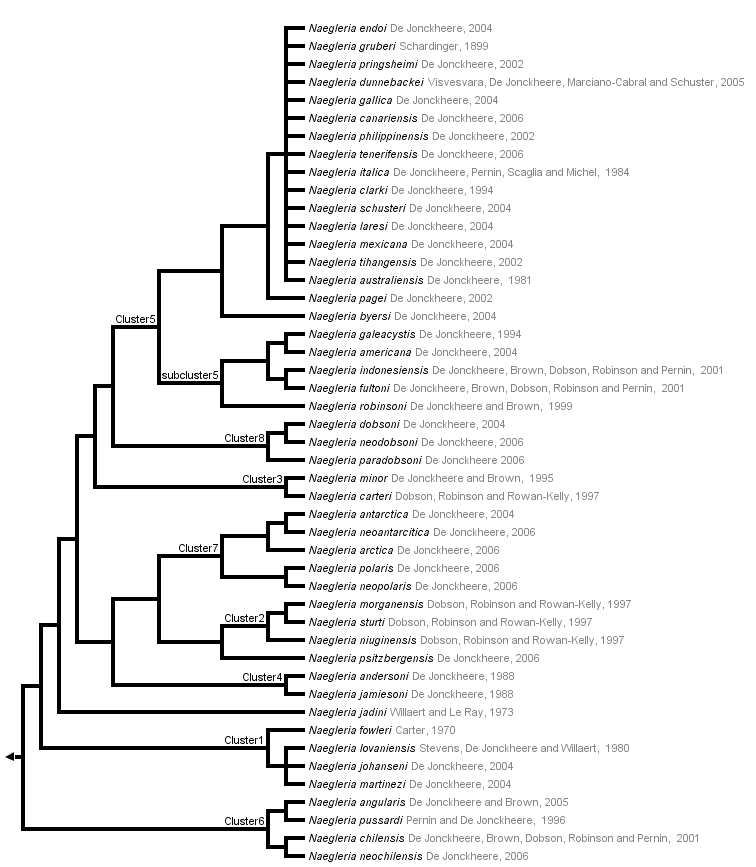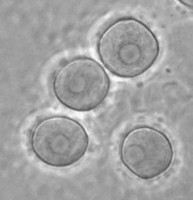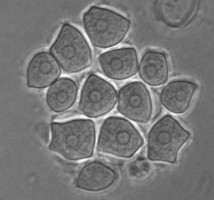Naegleria
Johan F. De Jonckheere


This tree diagram shows the relationships between several groups of organisms.
The root of the current tree connects the organisms featured in this tree to their containing group and the rest of the Tree of Life. The basal branching point in the tree represents the ancestor of the other groups in the tree. This ancestor diversified over time into several descendent subgroups, which are represented as internal nodes and terminal taxa to the right.

You can click on the root to travel down the Tree of Life all the way to the root of all Life, and you can click on the names of descendent subgroups to travel up the Tree of Life all the way to individual species.
For more information on ToL tree formatting, please see Interpreting the Tree or Classification. To learn more about phylogenetic trees, please visit our Phylogenetic Biology pages.
close boxIntroduction
In the genus Naegleria 47 different species have been distinguished mostly based on differences in rDNA sequences. After using SSU rDNA sequences (De Jonckheere 1994) it was found that the internal transcribed spacers, including the 5.8 S rDNA are more useful in the identification and description of species (De Jonckheere 1998). The genus is subdivided into 8 clusters, of which two contain species which are only found in cold environments (De Jonckheere 2006b).
The genus Naegleria is notorious because the species N. fowleri causes primary amoebic meningoencephalitis (PAM), almost invariably leading to death. Cases of PAM are detected worldwide and are mostly related to swimming in warm water, whereby the pathogen enters the brain via the nose. The pathogen N. fowleri grows at a temperature up to 45°C and shares this characteristic with the closely related N. lovaniensis. Therefore, these two species can be found in warm waters where other species cannot grow. Two other species, N. australiensis and N. italica, were found to be pathogenic in experimental animals, but no human cases are known yet (De Jonckheere 2002).
Most Naegleria spp. transform into flagellates with two flagella but nonflagellating species are known. Most species have flagellates which do not divide but in a few species division in the flagellate stage is observed. Almost all species form cysts with pores. There is some variation in cyst morphology (Fig. 1).



Fig. 1. Cysts of Naegleria gruberi and Naegleria angularis. © Johan F. De Jonckheere
Only for the genus Naegleria there is enough information about the dispersal in the environment. It appears that most species are present on all continents except Antarctica (De Jonckheere 2004). In Antarctica and Arctica Naegleria spp. are present that are only found in cold environments (De Jonckheere 2006b). The pathogenic N. fowleri on the other hand is only present in warm climates or hot waters in temperate climates.
In the genus Naegleria the rDNA genes are on a circular plasmid, which was estimated to be present in 4,000 copies (Clark and Cross 1988). In several species of Naegleria, a group I intron is present in the SSU rDNA, and in a few species also in the LSU rDNA (De Jonckheere 2002, 2004). Group I introns are autocatalytic genetic elements carrying a ribozyme domain responsible for the intron self-splicing reaction, and occasionally a homing endonuclease gene, encoding an endonuclease protein directly involved in the intron mobility at the DNA level. In the genus Naegleria, the group I introns almost all carry a homing endonuclease gene. It was demonstrated that the group I intron in the SSU rDNA of Naegleria spp. was acquired in an ancestral stage and inherited vertically, while it was lost in certain species. The group I introns in the LSU rDNA of Naegleria spp. would be recent horizontal transfers.
References
Clark, C. G., Cross, G. A. M. Small-subunit ribosomal RNA sequence from Naegleria gruberi supports the polyphyletic origin of amoebas. Mol. Biol. Evol. 5, 512-518, 1988.
De Jonckheere, J. F. Naegleria australiensis sp. nov., another pathogenic Naegleria from water. Protistologica 17, 423-429, 1981.
De Jonckheere, J. F. Naegleria andersoni n. sp. a cosmopolitan amoebo-flagellate, with two subspecies. Europ. J. Protistol. 23, 327-333, 1988.
De Jonckheere, J. F. Comparison of partial SSUrDNA sequences suggests revisions of species names in the genus Naegleria. Europ. J. Protistol. 30, 333-341, 1994.
De Jonckheere, J. F. Sequence variation in the ribosomal internal transcribed spacers, including the 5.8S rDNA, of Naegleria spp. Protist 149, 221-228, 1998.
De Jonckheere, J. F. A century of research on the amoeboflagellate genus Naegleria. Acta Protozool. 41, 309-342, 2002.
De Jonckheere, J. F. Molecular definition and the ubiquity of species in the genus Naegleria. Protist 155, 89-103, 2004.
De Jonckheere J. F. Isolation and molecular identification of vahlkampfiid amoebae from an island (Tenerife, Spain). Acta Protozool. 45, 91-96, 2006a.
De Jonckheere J. F. Isolation and molecular identification of vahlkampfiid amoebae from Arctic and sub-Antarctic regions. Europ. J. Protistol. 42, 115-123, 2006b.
De Jonckheere, J. F., Brown, S. Willaertia minor is a species of Naegleria. Europ. J. Protistol. 31, 58-62, 1995.
De Jonckheere, J. F., Brown, S. SSUrDNA analysis reveals the existence of a second Naegleria sp. with dividing flagellates: N. robinsoni sp. nov. Europ. J. Protistol. 35, 264-266,1999.
De Jonckheere, J. F., Brown, S. Description of a new species with a remarkable cyst structure in the genus Naegleria: Naegleria angularis sp. n. Acta Protozool. 44, 61-65, 2005.
De Jonckheere, J. F., Brown, S., Dobson, P. J., Robinson, B. S., Pernin, P. Protist, 152, 115-121 2001.
De Jonckheere, J. F., Pernin, P., Scaglia, M., Michel, R. A comparative study of 14 strains of Naegleria australiensis demonstrates the existence of a highly virulent subspecies: N. australiensis italica n. ssp. J. protozool. 31, 324-331, 1984.
Pernin, P., De Jonckheere. Naegleria pussardi, a new Naegleria species phylogenetically related to the high temperature tolerant species at the molecular level. Europ. J. Protistol. 32, 403-411, 1996.
Robinson B.S., Christy P.E., De Jonckheere J.F. Observations on a temporary flagellate stage in Vahlkampfiid amoeba Willaertia magna and its significance for the phylogeny of the related genus Naegleria. Biosystems, 23, 75-86,1989.
Stevens, A. R., De Jonckheere, J. F., Willaert, E. Naegleria lovaniensis new species: isolation and identification of six thermophilic strains of a new species found in association with Naegleria fowleri. Int. J. Parasitol. 10, 51-64, 1980.
Visvesvara, G. S., De Jonckheere, J. F., Marciano-Cabral, F., Schuster, F. L. Morphologic and molecular identification of Naegleria dunnebackei n. sp. isolated from a water sample. J. Eukaryot. Microbiol. 52, 523-531, 2005.
Willaert, E., Le Ray, D. Caractères morphologiques, biologiques et immunologiques de Naegleria jadini sp. nov. (Amoebida, Vahlkampfiidae), Protistologica 9, 417-426, 1973.
About This Page
This page is being developed as part of the Tree of Life Web Project Protist Diversity Workshop, co-sponsored by the Canadian Institute for Advanced Research (CIFAR) program in Integrated Microbial Biodiversity and the Tula Foundation.

de Duve Institute and Scientific Institute of Public Health, Belgium
Correspondence regarding this page should be directed to Johan F. De Jonckheere at
Page copyright © 2008
All Rights Reserved.
- First online 21 September 2008
- Content changed 21 September 2008
Citing this page:
De Jonckheere, Johan F. 2008. Naegleria. Version 21 September 2008 (under construction). http://tolweb.org/Naegleria/124653/2008.09.21 in The Tree of Life Web Project, http://tolweb.org/





 Go to quick links
Go to quick search
Go to navigation for this section of the ToL site
Go to detailed links for the ToL site
Go to quick links
Go to quick search
Go to navigation for this section of the ToL site
Go to detailed links for the ToL site